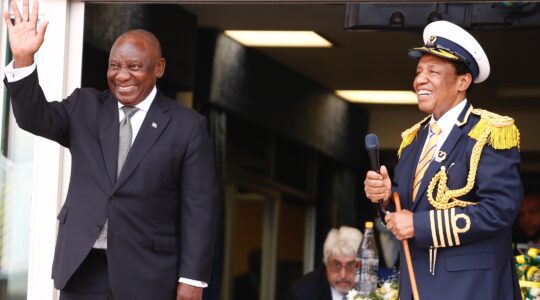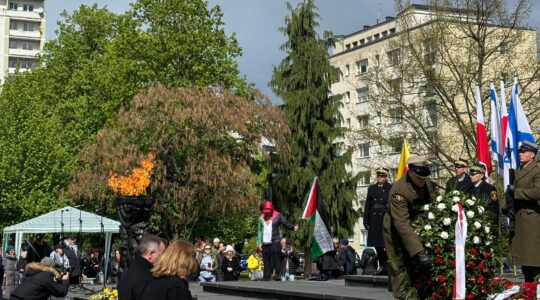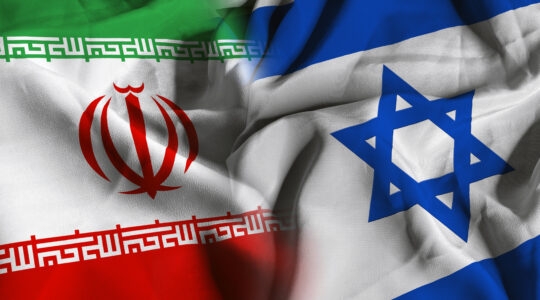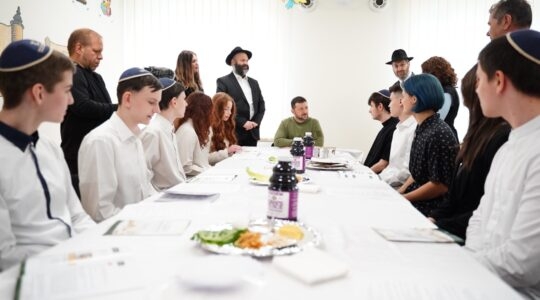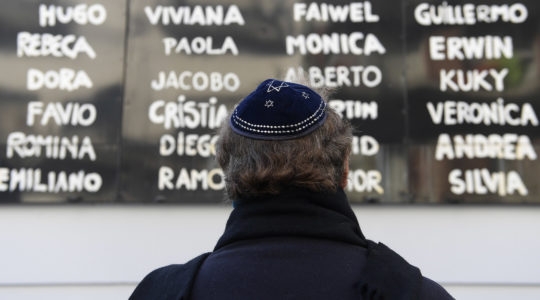FUKUYAMA, Japan (JTA) – About an hour north of Hiroshima, where the world’s first atomic bombing incinerated an entire city in a matter of seconds, a statue of a young girl stands in memory of another holocaust half a world away.
Anne Frank might seem out of place in rural Japan, but the man who founded the Holocaust Education Center here in 1995 feels a close link to the teenager whose diary became one of the most famous records of the Shoah.
Makoto Otsuka was a member of the Shinonome Chorus when the Osaka-based evangelical choir visited Israel in 1971. The group had just finished performing at an old-age home in Netanya when a man approached.
He had missed one piece – a survivor’s poem that the choir had set to music – but very much wanted to hear it, the man said. Would the group mind performing it again?
The man was Anne Frank’s father, and at the end of the performance he urged the group to spread awareness of the Holocaust and promote world peace.
Otsuka, just 22 at the time, was awed by Otto Frank and took his words to heart.
“I’ve met many Jews and leaders around the world, but I was especially inspired by him,” said Otsuka, now 58, who began a correspondence with Frank that lasted until Frank’s death in 1980. “He was a very positive person, very open-minded.”
“That meeting really changed my life,” he said. “For 37 years I’ve been doing that work.”
That sense of mission led Otsuka to open the Holocaust Education Center on the outskirts of Fukuyama, a city of nearly 400,000. But as the center grew more popular – some 40,000 Japanese schoolchildren have visited since its founding in 1995 – the original building proved too small.
With donations from the public and support from the pro-Israel evangelical group Beit Shalom – Otsuka is one of the group’s ministers – he opened a larger center last October. Israeli Ambassador Nissim Sheetrit attended the dedication.
On a recent Saturday, Yasushi Kawagoe, 39, brought members of his church, which is part of Beit Shalom, from the nearby city of Okayama. Kawagoe had been to Poland on the March of the Living, and the experience affected him deeply.
“It’s hard to put into words what happened,” he said, choking up and pausing to compose himself. “I had heard a lot about it, but [at Auschwitz] I felt what had happened, I felt the Jews’ fear. I thought: What can I do to help, to explain this to children?”
The younger generation “has heard about it once or twice, but just from books,” Kawagoe said. “Here they don’t just read about what happened, they can feel it.”
Kawagoe’s church group included three 11-year-old girls who had been to the center with their local elementary school class but wanted to return to learn more. They were especially taken aback by photos of signs prohibiting Jews from entering public parks and of Jews wearing yellow stars on their clothing.
“We’d be very sad if we had to wear a badge,” said one of the fifth-graders. The schoolchildren preferred not to give their names. “I don’t want to discriminate against any group of people. Japanese people and Jewish people are exactly the same. There are no differences.”
Otsuka says the idea of opening a Holocaust center came to him in a dream, and when he prayed he received inspiration to open it in Fukuyama. The location is ideal, he says – within Hiroshima Prefecture, but far enough away from the city that it’s not overwhelmed by Hiroshima’s own catastrophe.
“These were both very sad tragedies from the previous century, but they are not the same,” Otsuka said. “In Hiroshima, that tragedy occurred in a time of war, but the Holocaust is different – it’s about racial prejudice and about the indifference of mankind. It’s more fundamental.
“It’s true that it also happened in a time of war, but that anti-Jewish prejudice had existed for more than 2,000 years. It didn’t come about all of a sudden,” he said.
Still, some people ask why the center doesn’t include historical tragedies that involved the Japanese, such as the atomic bombings or the Rape of Nanking, carried out by Japanese soldiers in China in 1938.
“One person has just one subject,” Otsuka said. “By concentrating on one subject, we are able to illuminate other fields.”
This focus on the particular, a typically Japanese sensibility, is apparent at the center. Otsuka visited many Holocaust centers, including the Yad Vashem Holocaust Memorial in Jerusalem and the U.S. Holocaust Memorial Museum in Washington, while planning his own.
He lacked the resources to compete with those institutions, but he also believed their approach wasn’t appropriate for Japan, where the culture emphasizes quality over quantity.
“Japan is different: By exhibiting one shoe [from a concentration camp inmate], it suggests other shoes. By showing one flower, you can imagine all nature,” he said. “Sometimes exhibiting in a simpler way is more powerful. It stays in your heart.”
That was true for Masako Mifume, a teacher from Okayama who had been to the center before with a group of her students, but this time had come alone to do some sketching.
Sitting in a room with photos of pre-Holocaust life in the Lithuanian shtetl of Eishyshok, where some 900 Jewish children were murdered in the Shoah, Mifume was making small watercolors of a child’s shoe and Star of David badges.
“It’s very difficult to convey the Holocaust to Japanese students – they’re so into their games, their mobile phones,” she said. “Surrounded by a sea, they feel very disconnected from other countries. It’s so difficult for them to understand other cultures.”
Building those bridges of understanding has been Otsuka’s life’s work. In the new center’s first month, he gave more than 40 speeches to visiting groups.
“We’re just a drop in the ocean here,” he said, “but if even one person is inspired, then they will help spread the word.”
